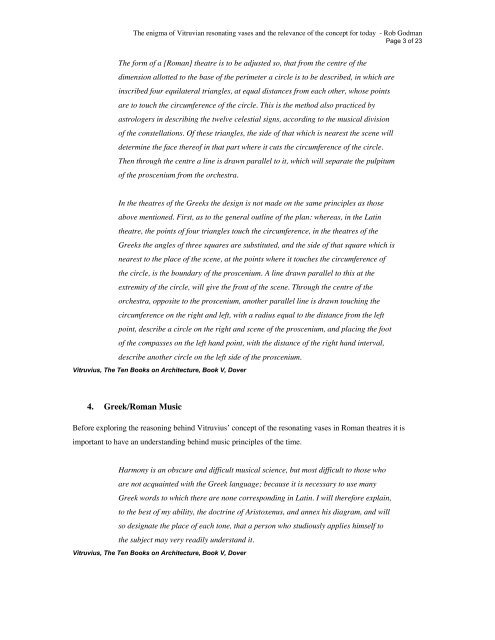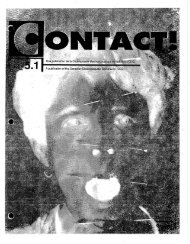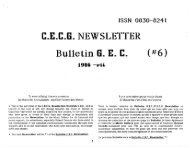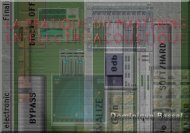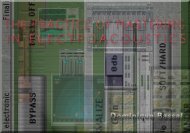The enigma of Vitruvian resonating vases and the relevance ... - CEC
The enigma of Vitruvian resonating vases and the relevance ... - CEC
The enigma of Vitruvian resonating vases and the relevance ... - CEC
You also want an ePaper? Increase the reach of your titles
YUMPU automatically turns print PDFs into web optimized ePapers that Google loves.
<strong>The</strong> <strong>enigma</strong> <strong>of</strong> <strong>Vitruvian</strong> <strong>resonating</strong> <strong>vases</strong> <strong>and</strong> <strong>the</strong> <strong>relevance</strong> <strong>of</strong> <strong>the</strong> concept for today - Rob Godman<br />
Page 3 <strong>of</strong> 23<br />
<strong>The</strong> form <strong>of</strong> a [Roman] <strong>the</strong>atre is to be adjusted so, that from <strong>the</strong> centre <strong>of</strong> <strong>the</strong><br />
dimension allotted to <strong>the</strong> base <strong>of</strong> <strong>the</strong> perimeter a circle is to be described, in which are<br />
inscribed four equilateral triangles, at equal distances from each o<strong>the</strong>r, whose points<br />
are to touch <strong>the</strong> circumference <strong>of</strong> <strong>the</strong> circle. This is <strong>the</strong> method also practiced by<br />
astrologers in describing <strong>the</strong> twelve celestial signs, according to <strong>the</strong> musical division<br />
<strong>of</strong> <strong>the</strong> constellations. Of <strong>the</strong>se triangles, <strong>the</strong> side <strong>of</strong> that which is nearest <strong>the</strong> scene will<br />
determine <strong>the</strong> face <strong>the</strong>re<strong>of</strong> in that part where it cuts <strong>the</strong> circumference <strong>of</strong> <strong>the</strong> circle.<br />
<strong>The</strong>n through <strong>the</strong> centre a line is drawn parallel to it, which will separate <strong>the</strong> pulpitum<br />
<strong>of</strong> <strong>the</strong> proscenium from <strong>the</strong> orchestra.<br />
In <strong>the</strong> <strong>the</strong>atres <strong>of</strong> <strong>the</strong> Greeks <strong>the</strong> design is not made on <strong>the</strong> same principles as those<br />
above mentioned. First, as to <strong>the</strong> general outline <strong>of</strong> <strong>the</strong> plan: whereas, in <strong>the</strong> Latin<br />
<strong>the</strong>atre, <strong>the</strong> points <strong>of</strong> four triangles touch <strong>the</strong> circumference, in <strong>the</strong> <strong>the</strong>atres <strong>of</strong> <strong>the</strong><br />
Greeks <strong>the</strong> angles <strong>of</strong> three squares are substituted, <strong>and</strong> <strong>the</strong> side <strong>of</strong> that square which is<br />
nearest to <strong>the</strong> place <strong>of</strong> <strong>the</strong> scene, at <strong>the</strong> points where it touches <strong>the</strong> circumference <strong>of</strong><br />
<strong>the</strong> circle, is <strong>the</strong> boundary <strong>of</strong> <strong>the</strong> proscenium. A line drawn parallel to this at <strong>the</strong><br />
extremity <strong>of</strong> <strong>the</strong> circle, will give <strong>the</strong> front <strong>of</strong> <strong>the</strong> scene. Through <strong>the</strong> centre <strong>of</strong> <strong>the</strong><br />
orchestra, opposite to <strong>the</strong> proscenium, ano<strong>the</strong>r parallel line is drawn touching <strong>the</strong><br />
circumference on <strong>the</strong> right <strong>and</strong> left, with a radius equal to <strong>the</strong> distance from <strong>the</strong> left<br />
point, describe a circle on <strong>the</strong> right <strong>and</strong> scene <strong>of</strong> <strong>the</strong> proscenium, <strong>and</strong> placing <strong>the</strong> foot<br />
<strong>of</strong> <strong>the</strong> compasses on <strong>the</strong> left h<strong>and</strong> point, with <strong>the</strong> distance <strong>of</strong> <strong>the</strong> right h<strong>and</strong> interval,<br />
describe ano<strong>the</strong>r circle on <strong>the</strong> left side <strong>of</strong> <strong>the</strong> proscenium.<br />
Vitruvius, <strong>The</strong> Ten Books on Architecture, Book V, Dover<br />
4. Greek/Roman Music<br />
Before exploring <strong>the</strong> reasoning behind Vitruvius’ concept <strong>of</strong> <strong>the</strong> <strong>resonating</strong> <strong>vases</strong> in Roman <strong>the</strong>atres it is<br />
important to have an underst<strong>and</strong>ing behind music principles <strong>of</strong> <strong>the</strong> time.<br />
Harmony is an obscure <strong>and</strong> difficult musical science, but most difficult to those who<br />
are not acquainted with <strong>the</strong> Greek language; because it is necessary to use many<br />
Greek words to which <strong>the</strong>re are none corresponding in Latin. I will <strong>the</strong>refore explain,<br />
to <strong>the</strong> best <strong>of</strong> my ability, <strong>the</strong> doctrine <strong>of</strong> Aristoxenus, <strong>and</strong> annex his diagram, <strong>and</strong> will<br />
so designate <strong>the</strong> place <strong>of</strong> each tone, that a person who studiously applies himself to<br />
<strong>the</strong> subject may very readily underst<strong>and</strong> it.<br />
Vitruvius, <strong>The</strong> Ten Books on Architecture, Book V, Dover


